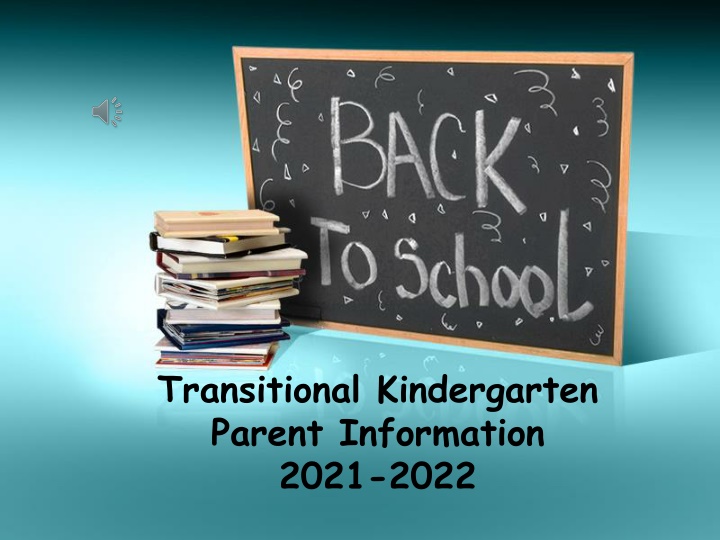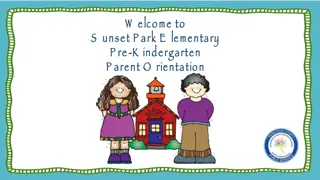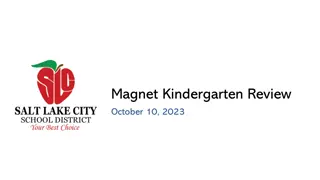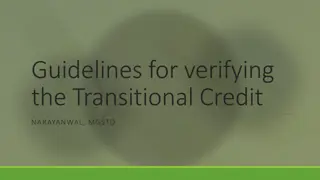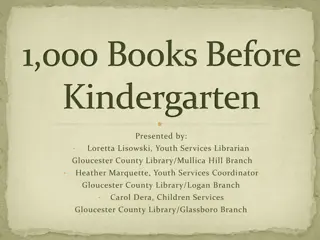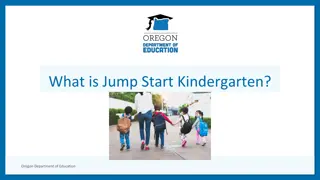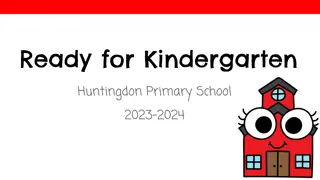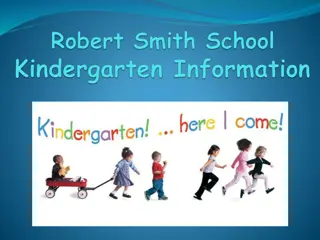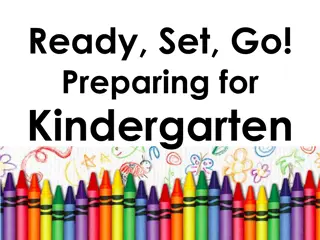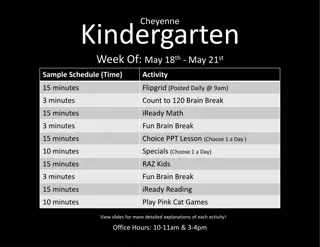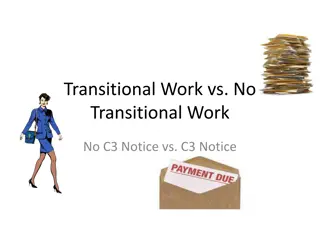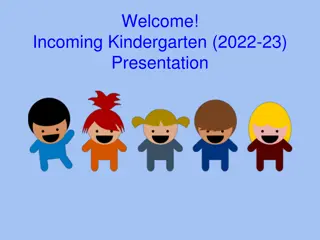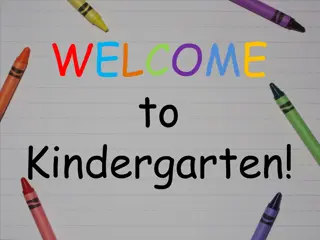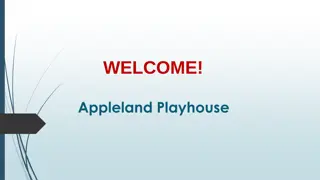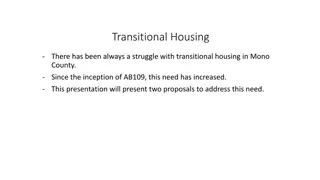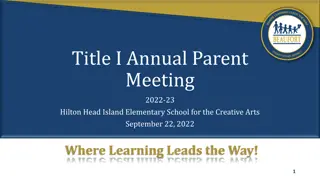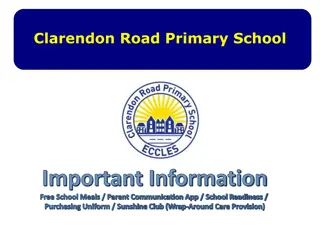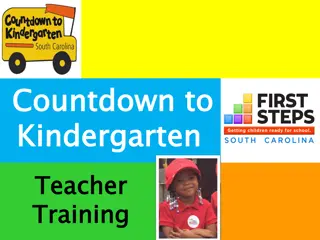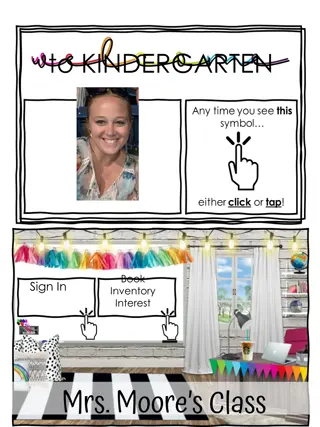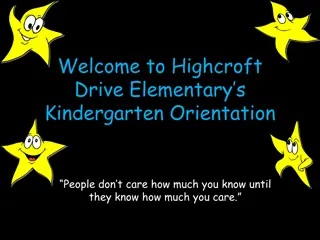Transitional Kindergarten Parent Information 2021-2022
Excited to share your child's learning journey in Transitional Kindergarten this year. Let's work together for their success. Topics include supplies, arrival/dismissal, restroom use, PAWS behavior program, and more. Stay connected through the Bloomz App. Immediate feedback is key to supporting young learners!
Download Presentation

Please find below an Image/Link to download the presentation.
The content on the website is provided AS IS for your information and personal use only. It may not be sold, licensed, or shared on other websites without obtaining consent from the author.If you encounter any issues during the download, it is possible that the publisher has removed the file from their server.
You are allowed to download the files provided on this website for personal or commercial use, subject to the condition that they are used lawfully. All files are the property of their respective owners.
The content on the website is provided AS IS for your information and personal use only. It may not be sold, licensed, or shared on other websites without obtaining consent from the author.
E N D
Presentation Transcript
Transitional Kindergarten Parent Information 2021-2022
Welcome I am excited to share what your child will be learning this year. It is important that we work together to help your child have a successful Transitional Kindergarten year. Please make sure you have added the Bloomz App to your phone. It s free, private, and an easy way for us to communicate quickly. When working with children this age, I feel it is beneficial for both of us to get immediate feedback.
Topics Supplies Arrival and Dismissal Restroom use PAWS Snack Growth Mindset Attendance Homework Grading What we will be learning Trimester 1 in Transitional Kindergarten Computer Skills Using Google Classroom Book Baggies How to Contact your teacher
Supplies a full size backpack (no wheels) a plastic pencil box children s scissors a pack of baby wipes (I will store the packs. We use them to clean up at lunchtime and art time)
Arrival and Dismissal Please follow the arrival and dismissal procedures that have been conveyed to you by school administration. Please follow all directions given by the staff on duty. Do NOT get out of your car in the drive through. Your children will go in and out of the Kindergarten gate. If you are driving through for pick-up, your child will be standing in front of the office. All other students will be sitting on the wall by the Kindergarten gate waiting for you to walk up. If they are meeting up with a sibling, I will seat your child at the sibling waiting area on the big playground. Once they are together, they will proceed to the appropriate pick-up area.
Restroom Use The students are allowed to use the restroom whenever they need to without asking permission. In addition to toilet paper, I keep a package of flushable wet wipes next to the toilet for the child s use if they like.
PAWS P- Positive Attitude A- Always Responsible W- Works and Plays Safely S- Shows Respect PAWS is a school-wide positive behavior program. Each day, the students are encouraged to try their best in class and make good choices to be excellent citizens in the classroom and around campus. Positive praise, stickers, stamps, and PAWS points are incentives available to students who make good choices. Improper behavior will result in appropriate consequences, but a positive approach will be emphasized. Issues will be handled in the classroom. Only continuous inappropriate behavior will be brought to your attention so that we can address it together. At the end of each month, I set up a PAWS shop at which students can spend their good points earned on fun items that I have purchased, the administrators have donated, or parents have donated. You can see points given and taken away each day under the behavior tab on Bloomz.
Snack The district has allotted only 15 minutes for us to eat and play each day. It would be ideal if you send a small snack for your child from home. The federal government is still providing free lunches to all students. I can make arrangements for your child to be taken to the cafeteria to have that lunch if that is what you prefer.
Classroom Expectations- Growth Mindset I am ready to learn. I will try my best. I will try it myself first. It is okay to make mistakes. I can and I will I will ask for help. I will learn the power of YET I will use my PAWS
Growth Mindset: What does it look like? Sitting and facing the teacher/parent/guardian Voice off when someone else is talking. Eyes on speaker No interrupting unless it is an emergency Raising hand at appropriate times when you have something to say. Waiting for teacher to call on you before you speak No shouting out. Being respectful of other's ideas. Be responsible with materials in school and at home.
Growth Mindset: What it doesn t look like Talking at inappropriate times like when someone else is talking. Sitting and not attempting my work. Not participating when working in groups or when someone asks me a question. Disturbing others when they are working Not being respectful of my peers, parents or teacher Not using materials correctly. (Pencils in mouth or breaking on purpose, bending books)
Attendance and Homework Multiple absences will be referred to administration. Students are expected to be in school everyday and on time. Homework is sent home at the beginning of the week and expected to return by the end of the week. I believe practice outside of school is an important part of mastering the academic and social/emotional skills. I also believe your family should be able to have choices about how and when the practice fits into your culture and lifestyle with your child s best interest in mind. Homework is not required. There is not a grade for it on the report card. In addition to weekly homework, my Google Classroom will have some skill practice opportunities and materials that can be printed out. It does not need to be returned. There are times that a project will be required to be returned. Also, any work that is not completed in class will be sent home to be completed. Between the information I give you Google Classroom and the work you see coming home, you should be able to get a clear idea of the skills your child is learning and our topics of discussion for the week.
Attendance and Homework continued... I would like the green wildcat folder you receive the first day of school to serve as the place holder for all communication that goes home or comes to school. Please help your student remember to keep it in their backpack at all times. Set aside a special place in your home designated just for homework (a place where there is as little distraction as possible). It is a good idea to keep supplies like crayons, pencils, scissors and glue in that area. Please have your child do all writing in pencil only (name, letters, words, etc.), and only things that specify coloring may be colored with crayons or colored pencil. Do not write your child s name for them! You may write it with a highlighter and then they can trace it.
What we will be learning in Trimester 1 Transitional Kindergarten Language Arts & Writing Listening Comprehension Letters Pencil Grasp Writing your name Tracing and Copying Correct Letter Formation Concepts of Print (author, illustrator, parts of a book) Listening and Speaking skills
What we will be learning in Trimester 1 Transitional Kindergarten Math? What is a number? Recognize and name number 1-5 Recite numbers 1-5 All about plane shapes Missing Parts of 4 and 5
What we will be learning in Trimester 1 Transitional Kindergarten Science and Social Studies Making Friends Rules 5 Senses Making Healthy Choices
What we will be learning in Trimester 1 Kindergarten Reading? The letter recognition and sounds for Mm, Aa, Ss, Tt, Nn, Ii, Ff, Pp, Oo, Cc plus the letters of heir name. Phonemic Awareness- blending and segmenting word families Concepts of Print (author, illustrator, parts of a book) Listening and Speaking skills Reading Comprehension (Listening Comprehension)
What we will be learning in Trimester 1 Kindergarten Writing Holding a pencil correctly Starting letters at the top and going down. Using lines correctly Writing name correctly (Capital at the beginning and lowercase letters for the rest of them) Starting writing on the left side of the paper. Going down to the next line. Copying a complete sentence using correct sentence formation. (Capital, spaces, punctuation) Adding details to drawing. Coloring inside the lines Drawing people with body parts Using 3 or more colors Using real colors
What in we will be learning in Trimester 1 Kindergarten Math Writing numbers to 10 correctly (starting at the top) Identifying 2D and 3D shapes Describing flat shapes using more than one attribute Sorting and describing objects Counting objects to 10 Composing and Decomposing numbers to 10
What we will be learning in Trimester 1 Transitional Kindergarten Science,Social Studies, Social Emotional What plants and animals need Introduce Seasons Rules and why we have them Being a Good Friend What are feelings and how to recognize them
Computer Skills Need to learn how to use a mouse Click, hold, drag Reading the words Done and Next Closing a program by clicking on the X Typing their own Username and Password Following Computer Rules (PAWS)
Using Google Classroom I will be using Google Classroom as a secondary learning tool. A weekly classroom newsletter can be found in the Stream . Supplementary activities and materials will all be posted here. Use the District Portal to access Google Suite Click here to access information how to access District Resources
Book Baggies The child chooses a book from the classroom basket to take home and typically returns it the next day. Please read the book your child brings home 100 times every night. (Ok, at least once, but more is better) Always use your finger or something to point to each word as it is read. Here are some things to do with the books you are reading each evening. Ask your child to: * take a picture walk and predict what the story is about *point to the title * find the front cover and back cover * count the words in the title * point to the beginning of a sentence *point to the end of a sentence *find a period *find a space between words * read sight words *retell the story from the beginning to the end *talk about the characters, setting, problem, and solution (if there is a problem and solution) There will be many times that your child will read and reread books. This is an excellent way to practice reading
How to contact your teacher D Track Transitional Kinder- Mrs. Folkman Google classroom code (a5zbqx) School phone 909 738 2180 Email tfolkman@cnusd.k12.ca.us Bloomz App
